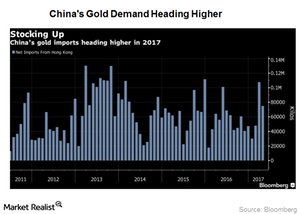What Rising Physical Gold Demand Could Mean for Prices
After falling 18% in 1Q17, physical demand for gold seems to have picked up in 2Q17.
Nov. 20 2020, Updated 1:15 p.m. ET

Physical demand for gold
After falling 18% in 1Q17, physical demand for gold seems to have picked up in 2Q17. While investors opted for riskier assets after the 2016 US Presidential election in the initial months of 2017, that optimism is now reversing. As we discussed previously in this series, recent geopolitical events have pushed investors toward safe-haven assets like gold.
India’s demand outlook
After last year’s demonetization move, which sucked the liquidity out of the Indian system, gold appetites are finally returning to India. Gold imports in May surged to 103 tons, which is four times the imports recorded in the same month last year. Jewelers in India are most likely building up their gold inventories, fearing a higher GST (goods and services tax) rate in coming months.
China’s gold demand outlook
The world’s largest consumer of physical gold, China (FXI), also seems to be back into the gold buying game. As the Chinese government is gearing up to rein in debt in its financial system, investors are finding solace in gold as an investment. The investment demand trend is clear from the increase in the sales of bars, which rose by more than 60% in 1Q17.
The WGC believes that both of these markets will continue to drive gold demand, despite short-term headwinds. This should support gold prices (NUGT) as well as gold stocks like Harmony Gold (HMY), Primero Mining (PPP), Kinross Gold (KGC), and Yamana Gold (AUY).
